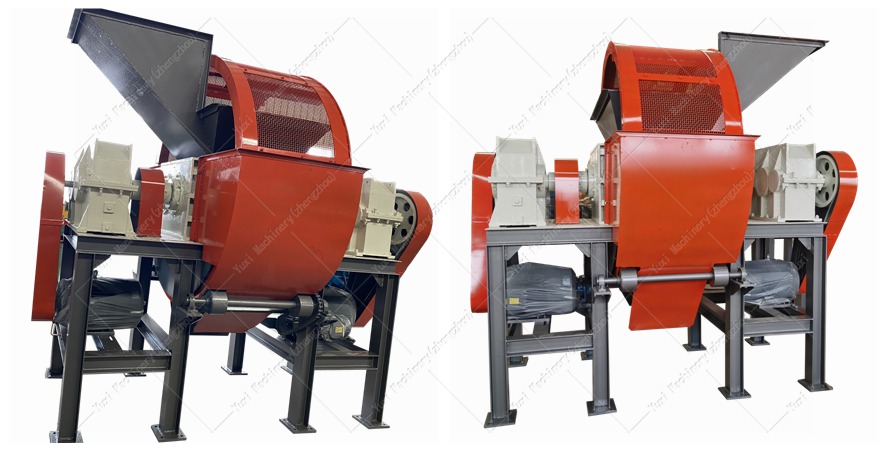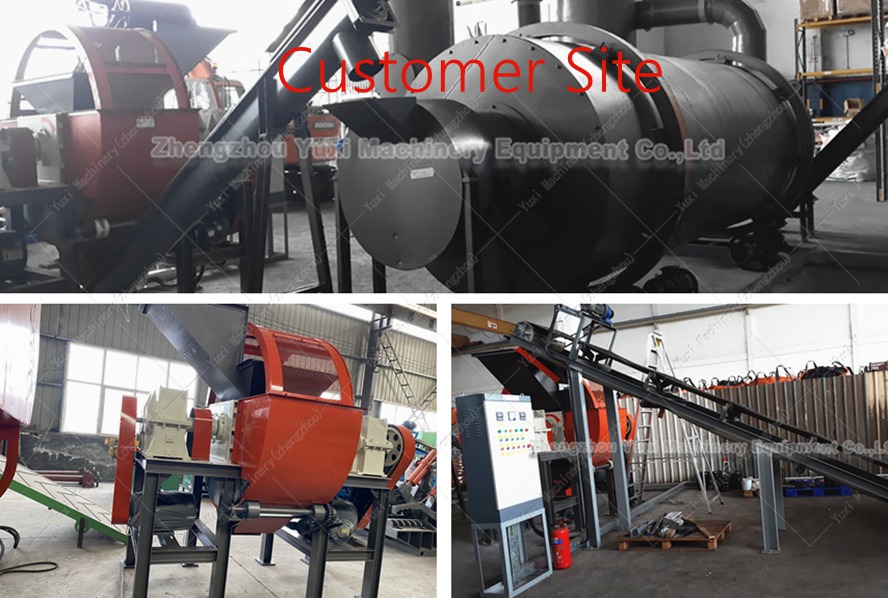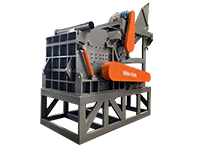As a core equipment in the fields of wood processing, garden waste disposal, and resource recycling, the wood shredder has become an ideal choice for wood shredding processing due to its technical advantages of low speed, high torque, and dust-free pollution. This article will deeply analyze the professional details of the wood shredder from the dimensions of equipment principle, core components, technical features, application scenarios, maintenance points, and selection guidelines.
1. Equipment Principle and Technical Architecture
The wood shredder is a shear-type crushing equipment, adopting a closed shear structure, and achieving highly uniform wood chip length through a controlled feeding method. Its working principle is to use the shearing action of the high-speed rotating blades and the fixed cutter head to crush materials such as wood, branches, and furniture scraps (edges and corners) into finished products of specified particle size.
From the perspective of power transmission, the equipment relies on a PLC control system to achieve automated operation, with functions of start, stop, reverse, and overload automatic reverse, effectively ensuring the stable operation of the equipment under complex working conditions, while avoiding equipment damage caused by material blockage.
2. Analysis of Core Components and Materials
The core performance of the wood shredder is determined by the material and structural design of its components, mainly including the following key parts:
• Frame and Shell: Welded from ASTM A36 high-strength steel, ensuring the structural stability of the equipment under high-torque operation, while providing protection for internal components.
• Inner Liner: Made of AISI 4140 wear-resistant alloy material, effectively resisting impact and friction during material crushing, and extending the service life of the equipment.
• Shaft and Cutter Head: The shaft is made of SAE 4340 quenched and tempered alloy steel, and the cutter head integrates multiple sets of alloy cutters - the cutter material is AISI H13 wear-resistant alloy, supporting multiple cutter configuration schemes, which can be flexibly selected according to material types (such as hardwood, softwood, garden waste, etc.) to achieve targeted crushing.
• Pulley and V-Belt: Responsible for power transmission, the tightness of the V-belt needs to be adjusted regularly (it is appropriate to press the middle part with a finger and drop 6-10mm) to ensure power transmission efficiency.

3. Technical Features and Performance Advantages
The professional performance of the wood shredder can be summarized as follows:
1. Low Speed and High Torque: The equipment is designed with a low speed and high torque output, suitable for crushing high-hardness and high-toughness materials, while reducing dust generation, meeting the dust emission limit requirements of the EPA (U.S. Environmental Protection Agency).
2. Wear Resistance and Durability: The material selection of AISI H13 alloy cutters and AISI 4140 inner liner makes it have low wear rate in long-term crushing operations, long maintenance cycle, and controllable comprehensive operating costs.
3. Automation and Intelligence: The application of the PLC control system enables the equipment to have functions such as automatic reverse and overload protection, complying with the NFPA (National Fire Protection Association) equipment safety standards, reducing manual intervention and improving production efficiency.
4. Controllable Finished Product Particle Size: The closed shear structure and controlled feeding design ensure the uniformity of wood chip length, meeting the particle size requirements of subsequent processing (such as biomass pellets, wood flour production, garden mulch, etc.) such as ASTM D1937 (wood particle size standard).
4. Application Scenarios and Industry Value
The application scenarios of wood shredders cover multiple fields, with significant resource recycling and industrialization value:
• Wood Processing Industry: Processing furniture processing residues and irregular wood, and crushing them for use in fields such as wood-based panels, papermaking, and biomass energy, complying with the FSC (Forest Stewardship Council) sustainable forestry standards.
• Garden Maintenance Field: Crushing garden wastes such as branches, tree trunks, and fallen leaves, and converting them into garden mulch, organic fertilizer, or biomass fuel, meeting the EU EN 15978 garden waste recycling standard.
• Resource Recycling Industry: Crushing waste wood and wooden packaging materials to help the development of circular economy, complying with the ISO 14001 environmental management system requirements.
5. Maintenance Points and Service Life Management
Professional maintenance is the key to ensuring the long-term stable operation of the equipment:
• Bearing Maintenance: The bearings in the shaft need to be regularly filled with grease conforming to ASTM D2596 standards to avoid bearing heating and damage due to lack of oil, which affects the normal operation of the equipment.
• Cutter and Inner Liner Inspection: Regularly check the wear of AISI H13 cutters, and replace or regrind them in time; if the inner liner is excessively worn, it needs to be replaced synchronously to ensure crushing efficiency.
• V-Belt and Pulley: In addition to adjusting the tightness, it is necessary to check the wear and cracks of the belt to avoid shutdown caused by belt breakage. The belt selection should comply with the RMA (Rubber Manufacturers Association) standard.
• PLC System Maintenance: Regularly clean the dust in the control box, check the wiring connections, and ensure that the automatic functions are triggered normally, complying with the UL 508A industrial control equipment safety standard.
6. Selection Guide and Parameter Reference
According to the processing capacity, material type and other requirements, the wood shredder provides multiple models for selection. The following is a parameter comparison of typical models (taking the Yux series as an example, the units meet European and American standards):
| Model | Power (Horsepower) | Processing Capacity | Material Size (Inches) | Hopper Size (Feet) | Equipment Weight (Short Ton) | Overall Dimensions (Feet) |
| YXS-600 | 40 | 2-3 Tons/Hour | 0.12-0.39 | 2.69*2.95 | 2.75 | 8.536.566.23 |
| YXS-1000 | 100 | 5-8 Tons/Hour | 0.12-0.39 | 3.94*3.28 | 6.28 | 9.846.566.23 |
| YXS-1600 | 200 | 12-18 Tons/Hour | 0.12-0.39 | 7.55*6.56 | 26.46 | 16.409.847.87 |
| YXS-2600 | 435 | 25-60 Tons/Hour | 0.12-0.39 | 10.50*6.56 | 93.60 | 26.9013.1214.11 |
Note: Customized equipment is supported according to customer needs, meeting European and American special working conditions and production capacity requirements such as ASTM and ISO.

7. Professional Q&A Session
1. What factors affect the tool replacement cycle of the wood shredder?
Answer: The tool replacement cycle is closely related to material hardness, processing capacity, AISI H13 tool material, and maintenance conditions. If processing hardwood or highly abrasive materials, the replacement cycle will be shortened; regular regrinding and maintenance can extend the service life of the tool.
2. How does the overload automatic reverse function of the PLC control system ensure equipment safety?
Answer: When the equipment is overloaded due to material blockage or other reasons, the PLC system will detect abnormal current or torque, trigger the reverse function, make the material move in the reverse direction, remove the blockage, and avoid equipment damage due to overload, complying with the NFPA 79 electrical safety standard.
3. What is the technical principle of environmentally compliant dust control?
Answer: The low-speed design reduces dust raise (lifting) during material crushing. At the same time, the closed structure limits the crushing process within the shell. With a dust removal device complying with EPA Part 63 standards, dust emission compliance is achieved.
4. What parameters should be focused on when selecting different models of wood shredders in the European and American markets?
Answer: It is necessary to focus on processing capacity (matching production capacity requirements), power (ensuring sufficient power, complying with NEMA motor standards), material size (ensuring smooth feeding, complying with ASTM material size specifications), overall dimensions (adapting to site space), and customization requirements (such as special material processing, integration of other equipment, etc., meeting UL and CE certification requirements).
In the industrialization process of wood processing and resource recycling, wood shredders have become a key equipment for cost reduction, efficiency improvement, and green development in the industry with their professional technical design, compliance with European and American standards, and efficient resource utilization capabilities. Whether meeting the particle size requirements of ASTM or complying with the environmental standards of EPA, its in-depth performance in technical details and industrial value provides a reliable solution for the global wood shredding field. If you have further needs in equipment selection, customization, or technical compliance, please feel free to communicate at any time, and we will support your production and development with professional technical support.
 Shredding Machine
Shredding Machine
 Waste Recycling Line
Waste Recycling Line
 Optional Equipment
Optional Equipment


